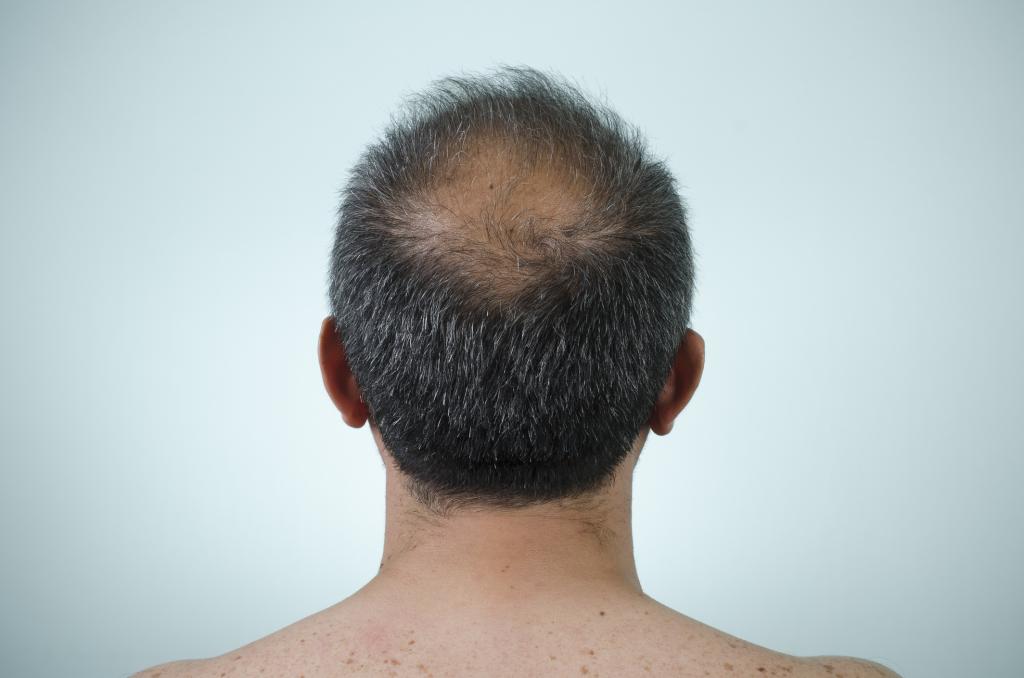Is your hair starting to thin or recede? The American Academy of Dermatology¹ estimates that approximately 80 million Americans suffer from hereditary hair loss. And if you’re facing hair loss, you likely want a solution that works as quickly and effectively as possible.
The best time to start treating hair loss is immediately – the moment you first notice excess hair in your brush, bald spots on your scalp, or thinning hair. Luckily, there are a number of effective treatment options for hair loss in men and women. Here are four of the best.
 1. Biotin
1. Biotin
Biotin is an oral supplement taken daily, and you can find it at your local drugstore and many big box retailers. Biotin is a B vitamin that serves as the primary ingredient in most hair, skin and nail multivitamins. It’s also one of the leading treatments for hair loss in both men and women due to its ability to stimulate hair growth while thickening nails and reducing inflammation in the skin, the Cleveland Clinic reports².
The catch is that there’s little to no scientific evidence that biotin can effectively stimulate hair growth or stop the loss of hair according to a study published in Skin Appendage Disorders³. That hasn’t stopped many doctors from recommending this vitamin for hair loss, and it doesn’t change the fact that many people have achieved noticeable results while taking biotin consistently.
If you’re searching for a natural solution for hair loss, this is the most effective option. Look for supplements that combine biotin with vitamin C, zinc, and folic acid for the best results. It can take weeks or months of consistent use to start seeing results, so don’t give up too soon. You can combine biotin with other hair loss treatments.
2. Propecia
Like biotin, propecia is an oral treatment for hair loss – but propecia is a prescription medication taken at the same time each day
According to Drugs.com⁴, propecia is a prescription medication used to treat hereditary hair loss or baldness in men. Also known as Finasteride, this medication is easily absorbed into the skin when touched. It causes hormonal changes that are only safe in men, so it’s important that women and children don’t handle the medication in any way.
This medication helps prevent hair loss only as long as it’s taken on a daily basis. Once you stop taking propecia, you can expect to start losing hair rapidly. It’s important to remain consistent over a long period of time to see the best results. It’s common for men to notice initial results after three months of daily use.
3. Rogaine
Rogaine is the most effective medication to treat hair loss in men and women according to Drugs.com⁵. You can grab Rogaine at any drugstore, and you simply apply it to your scalp twice daily. And you don’t need a prescription to buy it. It’s also known as minoxidil. While it’s clear this medication does stimulate new hair growth on the scalp, researchers haven’t yet discovered how or why it works. What we do know is it’s similar to propecia in that it only works while you’re taking it daily, so make sure you’re consistent.
You can expect to take Rogaine for many years in order to maintain your results. Most users will start seeing initial results after about four months of daily use. Most people start losing hair rapidly once they stop taking it.
There are separate Rogaine formulas for men and women, and it’s important to take the one that matches your gender. You shouldn’t take any form of this medication if you’re pregnant or may become pregnant in the near future because the effects on a developing baby are unknown. Talk to your doctor before taking Rogaine if you have heart disease.
4. Hair Transplant
You can always consider surgery when your hair loss is more drastic or if your scalp doesn’t respond to any other types of treatment. Men and women often resort to surgery if they can’t successfully slow or reverse hair loss through medication or dietary changes.
A hair transplant is the most common surgical intervention, and it only works for men and women who have a substantial amount of hair remaining on some parts of their scalp. The surgeon will remove scalp grafts from hair-covered areas and surgically implant them into bald or thinning areas of the scalp.
There are different techniques that surgeons may use to perform a hair transplant, and multiple strategies are often employed. You’re not guaranteed to walk out of surgery with a full head of hair, and some people see better results than others. In some cases, the new hair never completely merges with the hair on other areas of the scalp. Your surgeon’s skill and experience can influence your results.
You will need to schedule time for recovery because this is a tedious process that will require gradual healing of the scalp. Hair transplants are also costly. Rarely covered by health insurance, a hair transplant can cost anywhere from $4,000 to $15,000 according to Healthline⁶.
Reverse Your Hair Loss Today
Different lifestyle factors that can influence your rate of hair loss and your ability to grow new hair – but fortunately, with options like those above, you do have solutions that can regrow your hair and help you live life confidently again. From over-the-counter supplements to medications to surgical options, there’s a hair loss treatment out there that will help you get a full head of hair once again. Just make sure you do your research before beginning any treatment option or regimen.
Like anything, it’s always a good idea to be aware of the latest research. We recommend comparing at least 3 or 4 options before making a final decision. Doing a search online is typically the quickest, most thorough way to discover all the pros and cons you need to keep in mind.


